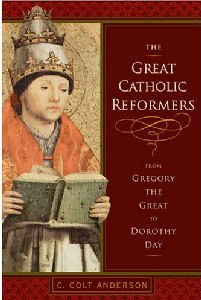
|
Posted December 15, 2008
Book: The Great Catholic Reformers: From Gregory the Great to Dorothy Day Author: C. Colt Anderson Paulist Press, New York. 2007. Pp. 262 An Excerpt from the Jacket:
The Great Catholic Reformers covers the careers of Pope Gregory the Great, Peter Damian, Bernard of Clairvaux, Clare of Assisi, Catherine of Siena, Jean Gerson, Jan Hus, Gasparo Contarini, John Henry Newman, and Dorothy Day. This diversity of reformers in our tradition suggests that legitimate reform within the Catholic Church can operate from different spiritualities, employ either gentle or harsh critiques, use secular or canon law to enforce discipline, and begin with lay men and lay women as well as with members of the religious or of the clergy. An Excerpt from the Book: At this time, it is impossible to assess the more lasting effects of Dorothy Day’s reform agenda because reform movements can take centuries to implement. Her efforts did help to reform labor conditions in America and her movement has directly assisted thousands of people in need. The social-justice agenda she advocated has met with less success among American Catholics — even though it was founded upon papal teachings that were received by the Second Vatican Council. It is evident that most American Catholics neither know nor actively support the church’s teaching on social justice. Even the institutions that officially claim to support a family wage, such as Catholic schools, parishes, and dioceses, frequently fail to practice what they preach when it comes to paying their employees a just wage. There are troubling signs for the social-justice reformers who wish to carry forward Dorothy Day’s attempt to reform society to be more just in accordance with the teachings of Leo XIII and Pius XI. Laws regulating working conditions are being rolled back in a frenzy of deregulation, support for mothers with dependent children has been cut dramatically, more and more people are falling through the cracks in a profit-based health-care system, and the unions are steadily declining in power as globalization presents new challenges to working people. Day’s advocacy of indiscriminate love and pacifism have also fallen out of favor. The terrorist attacks in 2001 and our response to them show that most Americans believe that violence is the best, most expedient means to solve conflict. The protection of the civil rights of religious and ethnic minorities, especially Muslims, has eroded to the point of the suspension of some civil liberties by the Congress. Even our politics have become less civil. Civic discourse has been replaced by ranting ideologues on the radio and the twenty-four hour “news” networks. The Internet has further added to the Balkanization of society because it allows people to avoid sources of information and opinions that contradict their own position. Rather than generating dialogue, the Internet seems to be promoting a series of disconnected monologues. Increasingly, politics are about creating wedge issues that provoke the type of class warfare Dorothy Day opposed. Table of Contents: 1. Gregory the Great 2. Peter Damian: The Doctor of Reform 3. Bernard of Clairvaux: The Impossible Reformer 4. Clare of Assisi: The Clear Mirror of Christ 5. Catherine of Siena: The Insatiable Reformer 6. When Reformers Collide: Jean Gerson and Jan Hus 7. Gasparo Contarini: Christ’s Diplomat 8. The Most Dangerous Man in England: The Convert Cardinal Newman 8. Dorothy Day and the Catholic Worker Movement |
|
